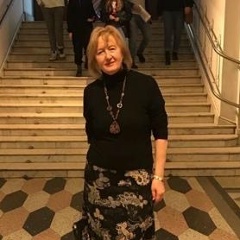https://youtu.be/fM_fpi0o3Qk
Кинохроника ленинградской блокады приоткрывает окно, выходящее на будни нашего многострадального города и тех самоотверженных тружеников, которые в течение почти 900 дней теплили в нем жизнь, помогая ему стойко переносить налеты немецко-фашистской авиации.
На Марсовом поле вырыты окопы, солдаты устанавливают орудия противовоздушной обороны. Разрушенные здания, дома, будто разрезанные продольно вафельные торты. На подступах к городу установлены заградительные полосы. Эвакуируют знаменитые скульптуры Клодта с Аничкова моста: несколько мгновений — и мост гол, а решетка ограды изломана, продырявлена вражеской артиллерией. Висят афиши балета «Евгений Онегин». Удивительное дело наблюдать балет в истощенном блокадой городе! Но это, своего рода, пощечина врагу: ты хотел нас на колени поставить, но не тут-то было — мы хотим почувствовать себя свободными людьми. Насколько это возможно. Наш дух тебе не сломить. Танк Т-34 съезжает с Троицкого моста и поворачивает на Дворцовую набережную. Объявление на стене: «Продаю или меняю на папиросы и продукты». В списке значатся как венские стулья, так и простая кухонная утварь. Под снегом хмурым караваном стоят троллейбусы. Разбираемые на доски трибуны футбольного стадиона, трупы закоченевших на морозе людей, взваленные на санки гробы…
Можно долго продолжать описывать моменты и эпизоды, попавшие в объективы кинокамер отчаянных операторов-энтузиастов блокадного Ленинграда. Но лучше увидеть, тем более что фильм несложно отыскать. Режиссер Лозница при выборке сюжетов поставил перед собой задачу передать не ужасы и кошмары блокады, от которых стынет в жилах кровь, а скорее атмосферу каждодневно борющегося за свое право быть, скованного со всех сторон неприятелем города. И продолжающего жить, ставя в тупик капиталистов из стран еще не открытого к тому времени западного фронта. Любовно и с известной долей скорби переходящий от здания к зданию, от решетки к решетке взгляд оператора рисует живую картину Ленинграда тех лет. Знакомые с детства фасады домов, улицы, переулки, соборы все же воспринимаются несколько отстраненно — в кадре непривычно мало людей…
Кинохроника ленинградской блокады приоткрывает окно, выходящее на будни нашего многострадального города и тех самоотверженных тружеников, которые в течение почти 900 дней теплили в нем жизнь, помогая ему стойко переносить налеты немецко-фашистской авиации.
На Марсовом поле вырыты окопы, солдаты устанавливают орудия противовоздушной обороны. Разрушенные здания, дома, будто разрезанные продольно вафельные торты. На подступах к городу установлены заградительные полосы. Эвакуируют знаменитые скульптуры Клодта с Аничкова моста: несколько мгновений — и мост гол, а решетка ограды изломана, продырявлена вражеской артиллерией. Висят афиши балета «Евгений Онегин». Удивительное дело наблюдать балет в истощенном блокадой городе! Но это, своего рода, пощечина врагу: ты хотел нас на колени поставить, но не тут-то было — мы хотим почувствовать себя свободными людьми. Насколько это возможно. Наш дух тебе не сломить. Танк Т-34 съезжает с Троицкого моста и поворачивает на Дворцовую набережную. Объявление на стене: «Продаю или меняю на папиросы и продукты». В списке значатся как венские стулья, так и простая кухонная утварь. Под снегом хмурым караваном стоят троллейбусы. Разбираемые на доски трибуны футбольного стадиона, трупы закоченевших на морозе людей, взваленные на санки гробы…
Можно долго продолжать описывать моменты и эпизоды, попавшие в объективы кинокамер отчаянных операторов-энтузиастов блокадного Ленинграда. Но лучше увидеть, тем более что фильм несложно отыскать. Режиссер Лозница при выборке сюжетов поставил перед собой задачу передать не ужасы и кошмары блокады, от которых стынет в жилах кровь, а скорее атмосферу каждодневно борющегося за свое право быть, скованного со всех сторон неприятелем города. И продолжающего жить, ставя в тупик капиталистов из стран еще не открытого к тому времени западного фронта. Любовно и с известной долей скорби переходящий от здания к зданию, от решетки к решетке взгляд оператора рисует живую картину Ленинграда тех лет. Знакомые с детства фасады домов, улицы, переулки, соборы все же воспринимаются несколько отстраненно — в кадре непривычно мало людей…
https://youtu.be/fM_fpi0o3Qk
The newsreel of the Leningrad blockade opens a window overlooking the everyday life of our long-suffering city and those selfless workers who for almost 900 days warmed life in it, helping it steadfastly endure the raids of German fascist aviation.
Trenches have been dug on the Field of Mars, soldiers are installing air defense weapons. Ruined buildings, houses, like waffle cakes cut longitudinally. On the outskirts of the city, barrier strips have been installed. The famous sculptures of Klodt were evacuated from the Anichkov Bridge: a few moments - and the bridge was bare, and the fence was broken, pierced by enemy artillery. Posters of the ballet "Eugene Onegin" are hanging. An amazing thing to watch ballet in a city exhausted by the blockade! But this is, in a way, a slap in the face to the enemy: you wanted to bring us to our knees, but it didn't work - we want to feel like free people. As much as possible. You cannot break our spirit. The T-34 tank drives off the Troitsky Bridge and turns onto the Palace Embankment. Announcement on the wall: "Sell or exchange for cigarettes and groceries." The list includes both Viennese chairs and simple kitchen utensils. Trolleybuses are standing in a gloomy caravan under the snow. The stands of a football stadium being dismantled on planks, the corpses of people numb in the frost, coffins heaped on sleds ...
One can go on for a long time describing the moments and episodes caught in the cameras of desperate cameramen-enthusiasts of besieged Leningrad. But it's better to see, especially since the film is easy to find. The director Loznitsa, while selecting the plots, set himself the task of conveying not the horrors and nightmares of the blockade, from which the blood runs cold, but rather the atmosphere of the city fighting every day for its right to be, fettered from all sides by the enemy of the city. And continuing to live, perplexing capitalists from the countries of the Western front that had not yet been opened by that time. Lovingly and with a certain amount of grief, the operator's gaze, passing from building to building, from lattice to lattice, paints a vivid picture of Leningrad in those years. Facades of houses, streets, lanes, cathedrals familiar from childhood are nevertheless perceived somewhat detached - there are unusually few people in the frame ...
The newsreel of the Leningrad blockade opens a window overlooking the everyday life of our long-suffering city and those selfless workers who for almost 900 days warmed life in it, helping it steadfastly endure the raids of German fascist aviation.
Trenches have been dug on the Field of Mars, soldiers are installing air defense weapons. Ruined buildings, houses, like waffle cakes cut longitudinally. On the outskirts of the city, barrier strips have been installed. The famous sculptures of Klodt were evacuated from the Anichkov Bridge: a few moments - and the bridge was bare, and the fence was broken, pierced by enemy artillery. Posters of the ballet "Eugene Onegin" are hanging. An amazing thing to watch ballet in a city exhausted by the blockade! But this is, in a way, a slap in the face to the enemy: you wanted to bring us to our knees, but it didn't work - we want to feel like free people. As much as possible. You cannot break our spirit. The T-34 tank drives off the Troitsky Bridge and turns onto the Palace Embankment. Announcement on the wall: "Sell or exchange for cigarettes and groceries." The list includes both Viennese chairs and simple kitchen utensils. Trolleybuses are standing in a gloomy caravan under the snow. The stands of a football stadium being dismantled on planks, the corpses of people numb in the frost, coffins heaped on sleds ...
One can go on for a long time describing the moments and episodes caught in the cameras of desperate cameramen-enthusiasts of besieged Leningrad. But it's better to see, especially since the film is easy to find. The director Loznitsa, while selecting the plots, set himself the task of conveying not the horrors and nightmares of the blockade, from which the blood runs cold, but rather the atmosphere of the city fighting every day for its right to be, fettered from all sides by the enemy of the city. And continuing to live, perplexing capitalists from the countries of the Western front that had not yet been opened by that time. Lovingly and with a certain amount of grief, the operator's gaze, passing from building to building, from lattice to lattice, paints a vivid picture of Leningrad in those years. Facades of houses, streets, lanes, cathedrals familiar from childhood are nevertheless perceived somewhat detached - there are unusually few people in the frame ...
У записи 3 лайков,
0 репостов,
208 просмотров.
0 репостов,
208 просмотров.
Эту запись оставил(а) на своей стене Евгений Марон
























